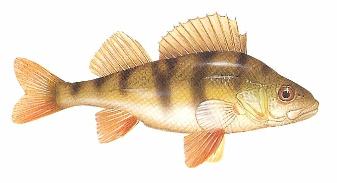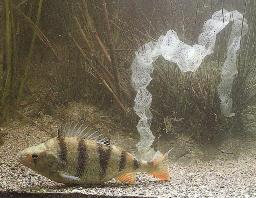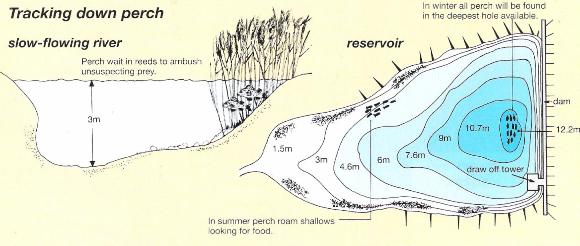

The Perch

Custom Search
Most pools, ponds, pits, canals and rivers hold perch.
The Vital statisticsScientific name - Perca fluviatllis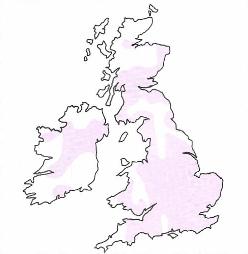 Life Span - 13 years
Life Span - 13 years
Maximum Weight - 71b (3.2kg) Maximum Length � 20in (50cm) Distribution � See map on right. Although the perch population was badly hit by disease in the 1970's this hardy fish has fought its way back and now most pools, ponds, pits, canals and rivers hold perch. Season � June to March in rivers. all year in stillwaters. Natural Diet � Fish, cruslaoes, worms and insect larvee.
Did you KnowPerch are the first fish to populate, naturally, the vast majority of newly flooded waters, and this is believed to be as a result of their extremely sticky eggs, whese will easily stick to the feet or feathers of nomadic water birds, thus transferring the species from water to water.Where do they hang out ?You may very well know which methods to use to catch them, but if you don't know where the fish are, then the method is no good to you.
Where will you find them ? - Look for deep, shaded water around wooden piles, bridge buttresses and sunken trees. On rivers the slack areas in weir pools are well worth exploring. Lily pads are favourite haunts for perch, you should fish as close to them as possible. Spinners in patterns such as ABU Toby, Atom and Reflex work well. A wire trace is an insurance against pike biting through the hne and won�t put the perch off. (When a spinner is moving through the water the perch don�t have time to inspect it, so they tend not to notice the trace.)
How do you catch them ?The fact is almost all methods in some form will work for them. You can try everything from float fishing to legering to lure fishing. You might even catch young perch free lining a maggot down the swim.Float Fishing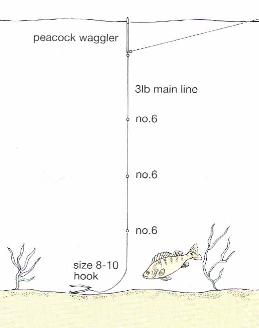 Lets start with Float fishing. This can be with anything from a maggot for the small fish to a small live or dead bait for the bigger ones, (remember to use a braided hooklength material, encase a pike should take the bait, it stands less chance of biting through the line.)
Lets start with Float fishing. This can be with anything from a maggot for the small fish to a small live or dead bait for the bigger ones, (remember to use a braided hooklength material, encase a pike should take the bait, it stands less chance of biting through the line.)
Just a reminder if you are fishing in Ireland - LIVE BAIT IS AGAINST THE LAW The rig on the right is a simple set up to get you going. This is perhaps the simplest way to catch perch, a worm under a straight peacock waggler. Bunch the bulk shot at the base of the float and put a few droppers down the line so the bait drops fairly slowly, if there are smaller fish towards the surface change the no. 6 shots to the middle in a cluster and this will drop the bait through to the bottom quicker. What to put on the hook ?They are partial to red worms, brandlings, small lobworms, maggots and castors. To keep them feeding throw in some chopped lobworms, they are excellent attractor.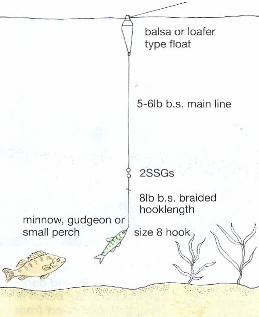
Want to try for something biggerIf you want to try for bigger fish the waggler will not cut it. You will need to step up to a balsa float. The balsa will allow you to fish further out and fish in faster flowing water. The rig on the left is suitable for this.What to put on the hookDead or alive, minnows and gudgeon or even small perch (they are cannibals), make ideal baits for bigger specimen. Use a braided hooklength as it will help prevent pike from biting through the line.Remember live bait is against the law in Ireland 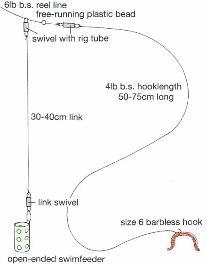
Lets have a look at LegeringIf you are looking for perch in larger deeper waters, they are going to be hard to find. One method is shown on the right. This is a leger rig with a lobworm on a 2 - 3 inch hooklength attached to the main line with a swivel covered with a rig tube. Attached to the main line above the swivel is an open-ended swimfeeder on an line 1 - 1.5 inchs long.Back to Perch Top Back to Know Your Fish Back to Home |






















